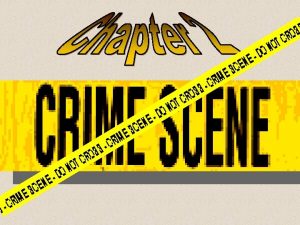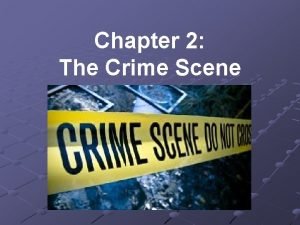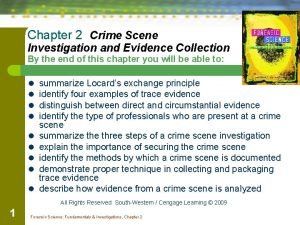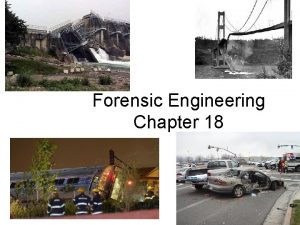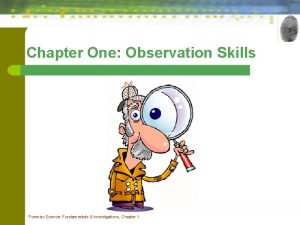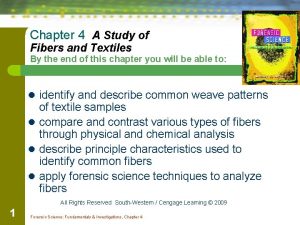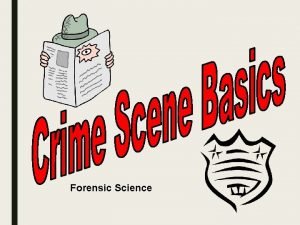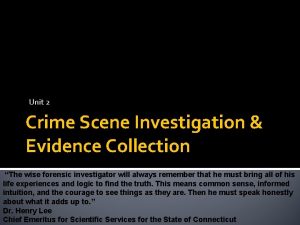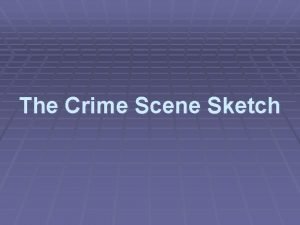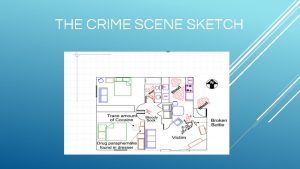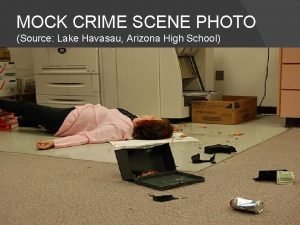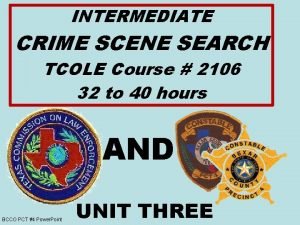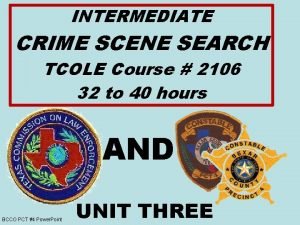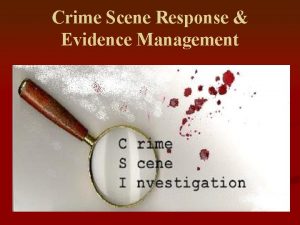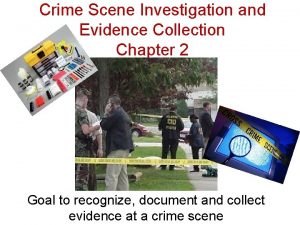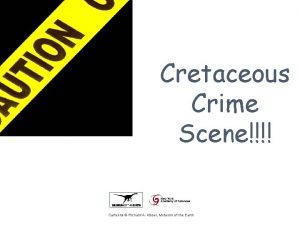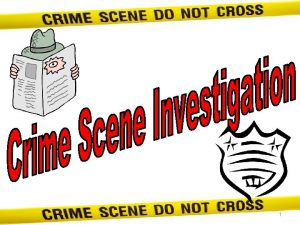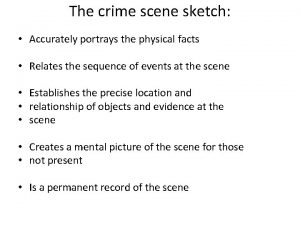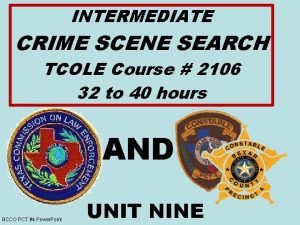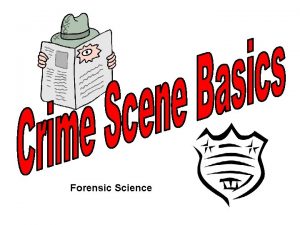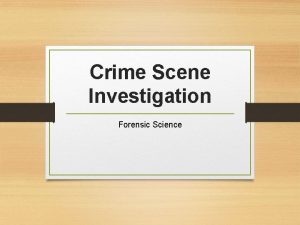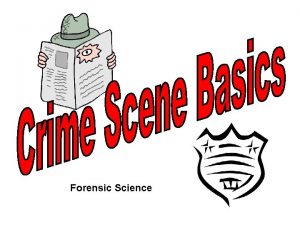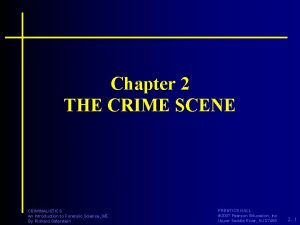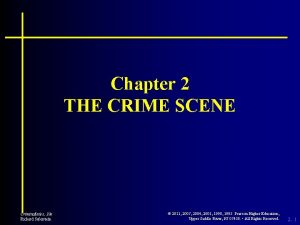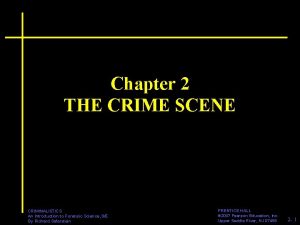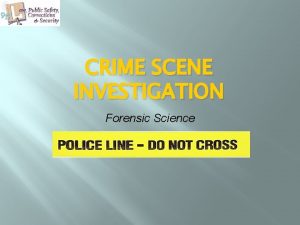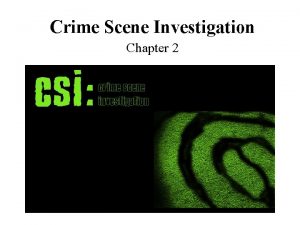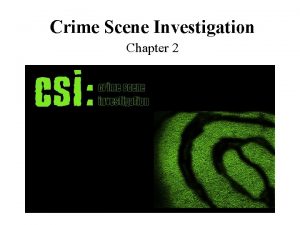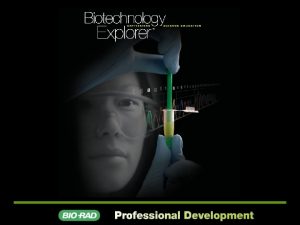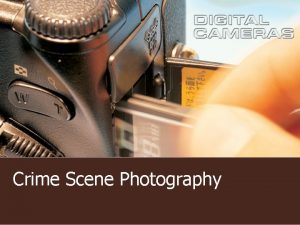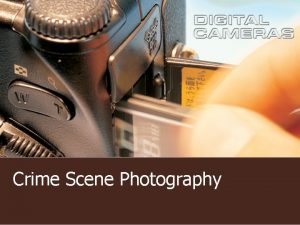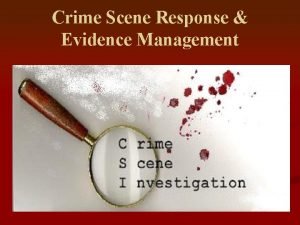Forensic Science Criminalistics Chapter 2 The Crime Scene









































- Slides: 41

Forensic Science Criminalistics Chapter 2 The Crime Scene

Physical Evidence Any and all objects that can establish that a crime has been committed or can provide a link between a crime and its’ victim or a crime and its’ perpetrator

Securing and Isolating a Crime Scene Duties of the Arriving Officer: � Get medical attention for suspect or victim � Arrest perpetrator if remaining on premises � Secure the Crime Scene

Securing and Isolating a Crime Scene �The Arriving Officer must prevent unauthorized or unneeded access: Unnecessary police officers Neighbors/Onlookers Members of the Media Every individual entering a crime scene can potentially destroy important evidence

Evaluate the Crime Scene �The Lead Investigator will: Determine the boundaries of the scene Document and photograph obvious evidence Develop a strategy for a systematic examination and documentation of entire scene

Methods of Crime Scene Recording �Photography & Videography May be limited by budget/personnel �Detailed Sketches with accurate measurements �Detailed Notetaking with descriptions of evidence collected

Crime Scene Photography �The crime scene must be unaltered and in the original state found by investigators �Must be photographed from all necessary angles �Evidence must not be moved prior to photography: if it has been moved, it cannot be reintroduced into the scene for photo purposes

Crime Scene Photography �Photos must be taken of the entire room and all rooms adjacent to initial crime scene �Close-up photos and panoramic photos are taken and sometimes include a ruler for scale �All pieces of physical evidence are photographed prior to removal

Crime Scene Videography �Increasingly popular due to affordable cost �Long-shots and close-ups are taken of scene �Narrations are often included as a method of note-taking

Crime Scene Sketching � Rough Sketch: An accurate depiction of dimensions of the scene, showing the location of all objects that may have implications to the crime. Done at the scene and used for finished sketch later


Rough Sketches �Objects are depicted from two fixed locations at the scene �Accurate measurements must be taken with a tape measure �Sketch evidence by using letters or numbers and a legend at the bottom �Sketch should always depict the NORTH direction

Finished Sketch � A precise depiction of the crime scene, drawn to scale � Sometimes drawn with the aid of a computer CAD: Computer-aided drafting

Notetaking at a Crime Scene �Constant activity at a crime scene that includes the following: A written description of the scene in a narrative format Location of physical evidence items recovered ▪ Time evidence discovered and by whom ▪ The condition of the evidence recovered


Typical types of Crime-Scene Searches Spiral Search Method: Begins from one point of the crime scene and continues in a spiral fashion to another point

Typical types of Crime-Scene Searches �Strip or Line Search: Several investigators begin side-by-side and search in a straight line and turn around and continue back on an adjacent part of the area

Typical types of Crime-Scene Searches �Grid Search: Investigators begin a search in an S-pattern from the a border of a crime scene and overlap the S-pattern on return

Typical types of Crime-Scene Searches � Quadrant or Zone: A small area or room is searched. It's used in homicides, rape, drug and bomb searches.

Types of Physical Evidence to Look For: � 1. Blood, semen, saliva, sweat

� 2. Hair/Fibers

� 3. Documents

� 4. Fingerprints

� 5. Glass/Paint/Powder Residues

� 6. Victim’s clothing

� 7. Fingernail Scrapings

� 8. Recovered bullets from the body

Integrity of Evidence �Blood, hairs/fibers, soil and dust should be submitted intact and should not be removed from garments or surfaces When these items are found on large objects that cannot be removed easily, evidence can be removed carefully using forceps or swabs

Packaging Evidence � Use wrapping paper, manila envelopes, paper bags are used for blood stained material Airtight containers are never used because they can readily grow molds and destroy evidence Airdry wet/bloody clothing and place in paper bags

Packaging Evidence �Use airtight containers for charred evidence from fires Prevents evaporation of accelerant Common packaging: ▪ Empty, unused paint cans ▪ Tightly sealed jars

Chain of Custody �A list of all persons who came into possession of an item of evidence �May include: collector, carrier, lab tech, evidence storage officer, investigator, medical examiner, etc �Unnecessary personnel should not handle evidence without justification prevents contamination

� This is an example of a chain of custody tag that should be attached to each piece of evidence to show who all has had possession of the evidence.

Standard/Reference Samples �Physical evidence whose origin is known, such as blood or hair from a suspect, that can be compared with crime scene evidence �Used as a comparison method to incriminate or exonerate a suspect or to identify a victim

Submitting Evidence to a Lab �May be completed by delivery or by mail �Should be done by someone familiar with the case �Includes an “Evidence Submission Form” stating the case history and type of exam requested �Must maintain Chain of Custody in all cases

Evidence Submission Form

Crime Scene Safety: Ways to Reduce Risks �Wear double gloves, protective footwear and clothing �Use masks/respirators, goggles or face shields �Be alert to sharp objects such as knives, needles, razor blades, etc. �Dispose of contaminated objects such as soiled gloves and clothing items that were worn by personnel

Crime Scene Safety: Ways to Reduce Risks �Complete notetaking with uncontaminated gloves to prevent contamination of pens and notebooks �Remove torn or contaminated material and discard immediately �No eating, drinking or smoking at the scene �All nondisposable linens or clothing should be labeled and laundered properly

Legal Considerations at the Crime Scene �All removal of evidence from a person or from the scene must conform to the Fourth Amendment: The right of the people to be secure in their persons, houses, papers, and effects, against unreasonable searches and seizures, shall not be violated, and no warrants shall issue, but upon probable cause, supported by oath or affirmation, and particularly describing the place to be searched, and the persons or things to be seized.

Warrantless Searches �Existence of emergency situations �Prevent the immediate loss or destruction of evidence �Search of a person or property following a lawful arrest �Search by consent

Mincey v. Arizona �After a homicide, police searched a scene for four days. Evidence collected was found to be inadmissible in court because the court did not feel that evidence would have been lost or destroyed in the time needed to obtain a legal search warrant.

Michigan v. Tyler �Fire destroyed a building and evidence was collected the first day at the scene. After the initial entry, later entries into the building produced evidence. All evidence from later entries to the property were deemed inadmissible in court.
 Forensic science begins at the crime scene.
Forensic science begins at the crime scene. Crime scene sketch
Crime scene sketch Hans gross forensic science
Hans gross forensic science American board of criminalistics
American board of criminalistics Youtube.com
Youtube.com Locard exchange principle
Locard exchange principle Forensic anthropologist vs forensic pathologist
Forensic anthropologist vs forensic pathologist Forensic psychiatry vs forensic psychology
Forensic psychiatry vs forensic psychology The golden book of camping
The golden book of camping What is nibis
What is nibis Forensic anthropology unit
Forensic anthropology unit Why are observation skills important in forensics
Why are observation skills important in forensics Forensic science fundamentals and investigations chapter 6
Forensic science fundamentals and investigations chapter 6 Weave patterns of fibers forensics
Weave patterns of fibers forensics Chapter 1 intro to forensic science
Chapter 1 intro to forensic science Crime scene investigation vocabulary
Crime scene investigation vocabulary Forensic science chapter 1
Forensic science chapter 1 Favorite subject is science
Favorite subject is science The west memphis three crime scene photos
The west memphis three crime scene photos Seven s of crime scene
Seven s of crime scene Types of crime scene
Types of crime scene Dena schlosser margaret schlosser
Dena schlosser margaret schlosser Finish sketch crime scene
Finish sketch crime scene Cross-projection sketch
Cross-projection sketch What is cross projection sketch
What is cross projection sketch Crime scene factoring and quadratic functions answer key
Crime scene factoring and quadratic functions answer key Rough sketch of crime scene
Rough sketch of crime scene Crime scene basics crossword answer key
Crime scene basics crossword answer key Intermediate crime scene search #2106
Intermediate crime scene search #2106 Intermediate crime scene investigation #2106
Intermediate crime scene investigation #2106 Crime scene factoring and quadratic functions answer key
Crime scene factoring and quadratic functions answer key Final sketch crime scene
Final sketch crime scene Crime scene
Crime scene While the csi team is searching the crime scene, _____.
While the csi team is searching the crime scene, _____. Crime scene vocabulary
Crime scene vocabulary Cretaceous crime scene
Cretaceous crime scene Crime scene vocabulary
Crime scene vocabulary What must be included on a crime scene sketch
What must be included on a crime scene sketch Strip search method crime scene
Strip search method crime scene Crime scene storyboard
Crime scene storyboard Robert pickton trailer
Robert pickton trailer Crime scene
Crime scene
